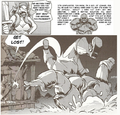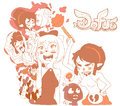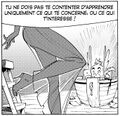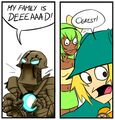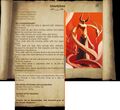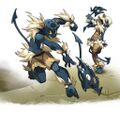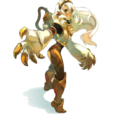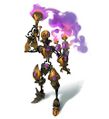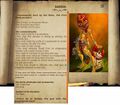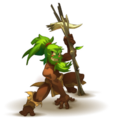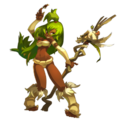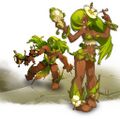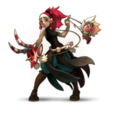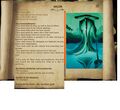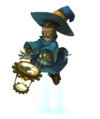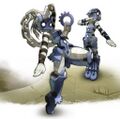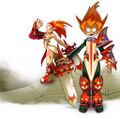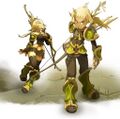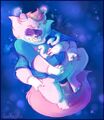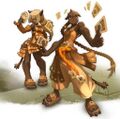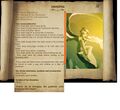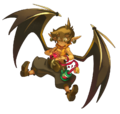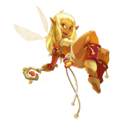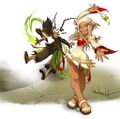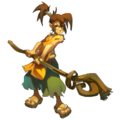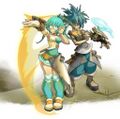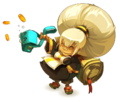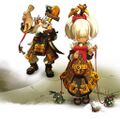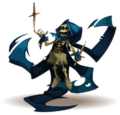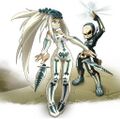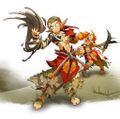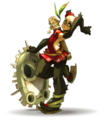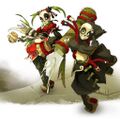Wakfu

Wakfu (as well as Dofus) is an animesque French setting about a fantasy world. Originally an MMO vidya called Dofus, a Saturday morning cartoon with a lot of action was made to promote the game (like Transformers, but with a monthly sub fee instead of action figures). The cartoon was called Wakfu and was set 200 years after the game. It ran for two seasons. It became fairly popular, both at home and in foreign countries like Albion and Eagleland. Then, an MMO for Wakfu was made, taking place a decade before the series. Then, a cartoon for Dofus was made, being intended for a younger audience than the first show. Between all these came several movies, a toy line, a trading card game, a tabletop game called Krosmaster, comics, and a Kickstarter for BLU rays and dubbed episodes that /co/ went into hysteric excitement for a month over.
/tg/ likes it for a some reason. Maybe it's the Noblebright fantasy setting with a fair amount of new concepts, maybe it's the elf panda and Felinid chicks with big hips, maybe it's just the fact that it's just a rather good cartoon. It's hard to pinpoint why, but the series definitely has some nice hips.
If you want to watch the series, both shows have been fansubbed in English, dubbed in French and Italian, and is being officially dubbed in English, Polish, and German. Ask /co/ where to look. /co/ loves Wakfu.
The Wakfu game itself is a free-to-play/pay-to-play MMO in closed beta. It's prequel, DOFUS, follows a similar formula; just that it's already been finished for a while.
Incidentally, if you read this and thought "Hey, that sounds cool, I remember when I used to like cartoons..." you really should go watch a bit: http://www.youtube.com/watch?v=H2JrWJfdoqk
The setting
Something of note is how many terms for creatures and things in the World of Twelve are spelled and pronounced differently, with minor differences from the real-world counterpart. For example, Krosmos=cosmos. Bouf=sheep. Bow Meow=cat with appendages allowing it to wrap around something and resemble a bow tie.
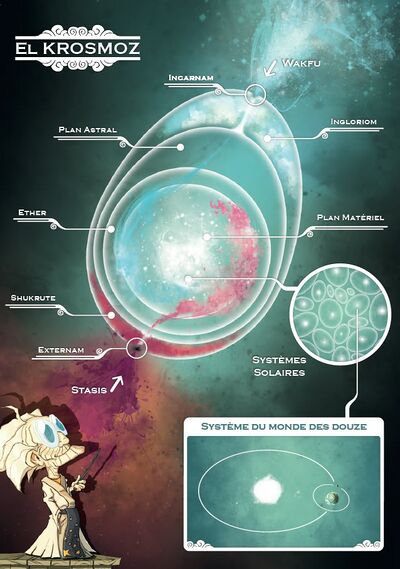
Krosmos
In the beginning, there was nothing but raw energy. This energy comes in two forms: "Wakfu" is the force of creation, and it occurs when the energy is in a state of movement. "Stasis" is the same energy, but destructive and is stagnant. This energy, in both forms, represents all matter and magic in the setting. Unlike most settings, they are not clear "good and evil" or "order and chaos". They simply are.
Eventually, the Wakfu of the universe formed into a sentient goddess entity called "Eliatrope". The Stasis became the god Great Dragon. The two circled each other in a "dance" (a princess and a dragon fucking, or a metaphor for a chemical reaction; you decide!). Out of this "dance" came a system of stable matter and complex wakfu/stasis flow. It resembles an egg. The "yolk " of the egg is the universe and all the solar systems within. The membrane is the Astral Plane called the Ether, and in the egg white on opposite ends are the realm of spirits and gods (Inglorium), and the realm of demons and Shushus (Shukrute). The former is on Eliatrope's side near the tip of the egg, the latter near the Great Dragon's on the bottom. When a being dies, their soul travels through the bottom of the egg out the Externam and flows through the Great Dragon, then enters the body of Eliatrope and returns to the universe in Incarnum to be reborn in a cycle of reincarnation.
Eliatropes and Dragons
With the universe created, the two gods danced a second time and created the first sentient mortal race. The firstborn twelve of that race hatched from eggs, called a Dofus, directly into the world. Six Dragons, six Eliatropes, one of each born as twins from each Dofus. Rather than dying, flowing through both genesis gods, and being reincarnated into a fetus produced via sexual reproduction somewhere in the material plane like most beings are, the first twelve of the Dragons and Eliatropes return to their Dofus upon death and once both Dragon and Eliatrope sibling perish and return they gestate and re-hatch from the Dofus egg as newborns. These are powerful conduits of Wakfu, and with proper use they can make beings extremely powerful. Eliatropes and Dragons do not look kindly on that by any means.
The rest of the Eliatrope and Dragon race are born, die, and reincarnate as everyone else does. The firstborn of their race wound up as their leaders.
They race built a great civilization, unlocking the secrets of Wakfu and Stasis as sciences. However, a long war with a race of machines and a few terrible internal betrayals scattered them across the Krosmos.
The World of Ten/Twelve
The Eliatropes and Dragons who survived the war with the machine race abandoned their empire and fled through the Krosmos. Eventually, most settled on a planet with an abundance of Wakfu. Eventually the machine men found them here as well, and wiped out life on the planet. Many escaped to pocket dimensions or took to the stars alone. The firstborn twelve, trapped in the Dofus's, were buried beneath the surface of the world.
Some time later, spirits and demons began to leave their home planes and explore the universe. By chance, a powerful spirit named Osamodas discovered the barren planet where the Eliatropes and Dragons made their last stand. He found only a sign made of platinum which read in flaming red letters "THERE'S NOTHING HERE". He made a home here, and his pets/companions, three great dragon spirits (unrelated to the Eliatrope dragons) played and fought like hounds at his feet. This, in the abundance of such a large amount of Wakfu, created simple life. Osamodas was joined by nine of his fellow spirits, who began to shape the world for life. Together, Sadida and Osamodas created the fauna and flora respectively. Xelor shaped time in ways that made it measurable, and gave it value. Enutrof gave the world gold and currency, Feca gave learning, and so forth. Many spirits began to converge on the world, all eager to be a part of this new wondrous thing. Since the gods had depleted most if their imaginative names by naming planets and celestial bodies during their travels through the Krosmos, they merely called the planet "The World of Ten".
Humans were born among the many different intelligent races on the planet, and among them humans had the most potential (though not inborn affinity like Eliatropes had)to shape Wakfu and Stasis. As the humans were born, they took shapes similar to the gods they worshiped and swore allegiance to as they reincarnated. The belief and servitude of man in turn made the spirits stronger until they became proper gods.
Meanwhile the race of Demons sought to invade, and take the world for themselves. As Demons came to be in the universe, born of Stasis more than Wakfu in contrast to the mainly Wakfu spirits, one called Rushu consumed the rest of the firstborn and declared himself supreme ruler of all successive generations of demons. Rushu came to the World of Ten early in it's formation and demanded to be one of the number of the gods. The Ten claimed balance must be maintained, and as a being of Stasis they could not balance him. In exchange for minor concessions, Rushu agreed to return to his realm and never enter the material plane again (he is not a clever Demon, simply the one in charge). Of course he breaks his agreement constantly, but has to control portals or cultists to send servants into the world. He also recruited mortal souls who shared his vision and turned them into Shushus. Those Shushus in turn have a tendency to be trapped into physical objects by humans, making powerful (if talking and snarky) items that can usually be identified by a visible eye along with the constant demands to use them to destroy something to stave off their boredom. During the early history of the world, Demons first learn to be truly evil. At their core they are only interested in destruction, for the act rather than any actual result. The worst task a Demon can end up with is building things for his fellows to destroy. Only by observing humanity from afar, and interviewing travelers who found portals leading to the realm of Rushu (which became more dangerous the more the demons learned) did they understand the implications of destruction. They learned of depravity and cruelty from mankind's knees. All were shocked by the depths of evil that humans could reach. Some, like Rushu, were eager students. Others saw it as pointless diversions, others saw it as heresy to the pure act of destruction.
Eventually, two more beings joined the gods. Sacrier, a minor and weak spirit, whispered her lessons, like "pain is weakness leaving the body" and "blood is a pretty color!" to a lumberjack until he became her prophet, spreading her faith throughout the world. Pandawa was a minor spirit who discovered a simple and effective way to make bamboo wine. This made her popular enough through gratitude that she earned enough worship-equivalent power to become a minor goddess, growing in followers until she was a goddess proper. Thus the world came to be known as "The World of Twelve".
Dofus Era
The Dofus era technically began when the god Xelor first made time able to be measured by converting much of his plane into a giant clock, and appointing twelve heroes to guard over the months (different events occurring involving them caused the different months to have different days and holidays. December only exists because Rushu scratched the clock and demanded one of his followers be made a protector as well). Sadida severed his soil soul and created ten dolls to seduce the three dragons of Osamodas (creating soul dolls is something the race of Sadidas also practice as a result). This creates the six Primordial Dofus, resulting in a race of Dragons in the World of Twelve.
The Dofus era comprises the general age of the first game. An age of myth preceded it in which heroes rose and wars were fought, mainly between the city states and later kingdoms Brakmar (city of villains and debauchery, established by Rushu for mortals to worship him after his first invasion) and Bonta (city of heroes and good alignments, established to oppose Brakmar). The main events from the age of myth however involve the rise of Goultard, immortal demigod son of Iop.
Dofus is an anachronistic age of heroic figures plumbing ancient ruins and fighting terrible monsters that threaten to sweep civilization away. The technology and culture of the time was something of a 1970's/1980's Shadowrun, with magitek conveniences like televisions and stereo sound systems to amp up rap battles and metal music concerts alongside standard fantasy things like swords and sorcery, crusades, and plagues on tier with something Nurgle could whip up.
The era ended with the rise of Ogrest.
Goultard the Barbarian
Originally detailed in a comicbook series, Goultard the Barbarian was remade as Ankama's first animated feature in the Wakfu setting. However, some parts had to be edited for television broadcast (polygamy for example) and the animation is considered embarrassing by them today so they generally want to pretend it doesn't exist. This was reinforced by the fact that the Kickstarter English dub, which supposedly will include everything, will not have it. Despite this it's quite well done and worth checking out if taken somewhat with a grain of salt.
Goultard was born from the union of the god Iop with one of his mortal followers, named Cabotine. She bore a son, whom she named Goultard into the world. The two were considered outcasts and were driven from the larger cities into the boonies. Here, Goultard's mother was kidnapped by a man-eating beast and the village simply wrote her off as not worth saving. Despite being only a small child, Goultard ventured forth and killed the beast to save her. This set a precedent for his life; killing shit, rescuing females, being a big damn hero. He doinked a lot of random chicks before finally falling for three witches. He married the three of them, and settled down to raise his children. However, a demon possessed Sacrier kidnapped and killed the lot of them. Goultard fell into a violent rage, killing the Sacrier but being possessed by the demon and shattering his sword (which he continued to use regardless). He took on the personality of "Dark Vlad" (along with a skin and hair color change to blue and white) and became a rampaging brute that could put an Everchosen to shame. Eventually, heroes from Bonta managed to calm him for his primary personality to reemerge, before it then split into further personalities. He spent the ages flitting in and out of legends, with the different personalities taking control and leading him on different paths. At some point he fought and defeated Rushu himself, and founded an order of Iops dedicated to protecting the world using Shushus bound to swords called Shushu Knights.
By the time of the Wakfu era, Goultard's own personality (somewhat akin to a MUCH more intelligent Goku with an animu-sword fetish) was the dominant one. He discovered a convention of sorts made by his own fans. Displeased, he proceeded to wreck the place. As he was leaving, a young Iop named Tristepin Percedal ran up to him. He laughed and told the boy that he was too late to buy any Goultard merchandise, but Tristepin said he didn't know what a Goultard was and just wanted to see a fight. He claimed that he would one day be known as "Tristepin De Percedal The Barbarian" and be a great warrior, then asked Goultard to teach him how to fight. At some point down the road, he did just that and made the boy his apprentice. It's stated that he died as well, although the circumstances aren't clear. After deciding that he'd spent enough time dead (don't you wish a certain someone was capable of that) he arose from his crypt, and began to treat his tomb like a resort in which to tan and practice fighting. This is where he's found in the Wakfu cartoon series (see below).
-
Cabotine don't take shit from NO man, not even her own god!
-
Young Goultard and Cabotine. Yes, he intends to eat that. Yes, he probably killed what it was attached to.
-
Adult Goultard doing what he does best.
-
Bitches love redheads covered in blood.
-
Goultard doing the OTHER thing he does best.
-
Goultard marrying one of his three wives.
-
Goultard's family is taken.
-
Why you don't piss Goultard off.
-
Goultard meets his protege.
-
Sums it up pretty well.
-
Goultard as he can probably be found post-Wakfu.
-
The origin of Rushu.
Dofus: The Treasures of Kerubim
The cartoon featuring the Dofus era came after the Wakfu cartoon, but predates it by an entire era in-story. It revolves around an elderly Ecaflip gentleman named Kerubim telling stories of his youth (and romantic exploits which mainly involve his attempts to win the love of his life, who is an Ouginak named Lou) to his adopted son Joris and his live-in Osamodas maid named Simone. A subplot involves Simone's lesbian relationship with an Ecaflip named Julie (meaning it'll never see daylight as anything other than an Adult Swim show in the United States unless they become French-kissing cousins) which was tastefully handled. Kerub was also in the Dofus game. The cartoon was generally self-contained stories, and had very little relevance to the ongoing plot other than world-building. An upcoming movie continues the story, and possibly explains how Joris seems to be an immortal being by the time of the Wakfu era.
-
Luis (the Shushu house), Kerub, Simone, and Joris. Watching TV in a fantasy world.
-
Julie and Simone.
-
Lou.
-
What most Wakfu fans got out of Treasures of Kerubim.
-
The OTHER thing most Wakfu fans got out of the show. Chiki wa.
-
Pissing off the young Kerub was unwise...
-
...unless you were big enough to ride a Tarrasque.
Ogrests Chaos
The primary cataclysmic event of the setting. One day, an alchemist named Otomai was experimenting with rare crystals made of solidified Wakfu called Ogrines and mixed them with CHEMICAL X. He managed to (accidentally) create a living being, whom he named Ogrest.
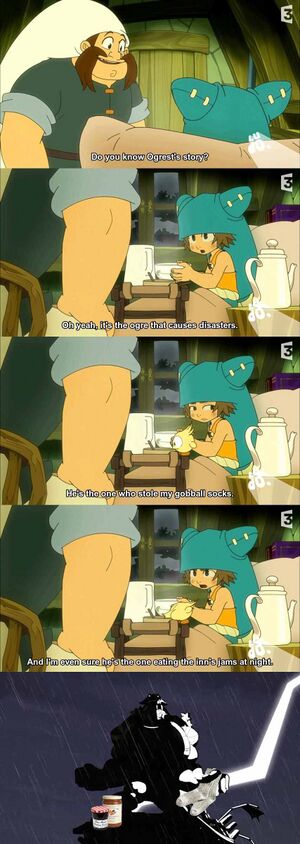
-
The supreme villain of the setting, Ogrest, wrestling with his maker Otomai.
-
Ogrest's revenge.
-
Ogrest atones and is purified.
-
Ogrest, temporarily subdued.
-
Ogrest meets Dathura. The fate of the World of Twelve is sealed.
Ogrest, thanks to his magically charged body, had peculiar properties to him like being nearly indestructible and having tears which grew as they fell (this was discovered when after being frightened as an infant he flooded his father's shop). His father cared for him and gave him a happy and sheltered childhood. And he would have had a pleasant life of it, in spite of the Chaos in all his works had his path not been crossed by a creature who causes more perplexity to man than the race of Boowolfs, Ouginaks, and Shushus put together; and that creature was a woman.
Dathura, one of the god Sadida's dolls, wanted to be a real girl. Recognizing Ogrest as a being of immense potential, she /ss/ed with him under his father's nose, then when he became an adult she manipulated him into collecting the six Primordial Dofus to use to turn her human. At one point during this time, one of the six Eliatrope/Dragon Dofus had hatched and the Eliatrope had perished, leaving the Dragon Grougaloragran to wander the world alone seeking the Dofus that contained his brother and those of his kin.
Once the Primordial Dofus were gathered the gods became fearful: Ogrest's might was near on par with their own. The Twelve declared war on him, and in the ensuing battles he cast them off their home on the tallest mountain in the World of Twelve, Mount Zinit (which at one point was the spaceship that carried the Eliatropes and Dragons to the World of Twelve). While exploring the entrances to the domains of the gods, Dathura fell into the Deep Abyss of Time, the realm of Xelor. Rather than try to find her, the great manchild began to weep. His tears, wailing, and fist pounding caused a cataclysm of near world-ending proportions. Tidal waves, earthquakes, and volcanic eruptions wiped out most of the life on the planet, and turned the Pangea-like continent into a series of large and small islands. Only the direct intervention of the gods saved mankind, and the continued effort saps them of their former strength. With the ensuing devastation, more people than ever before clung to the worship of the gods reducing the number of normal-looking humans in the world and granting the gods new strengths.
As civilization was rebuilt, the former twelve kingdoms were replace by small kingdoms and a large number of chaotic and transitory political systems which can rise and fall in a month. Most of these frontier city-states are founded and ruled by those who "have proven their worth to the gods and people" AKA adventurers murderhobos.
New organizations spanning the world arose, which behave similar to the faiths of the Twelve but are more like adventurer guilds or cults dedicated to myths and past figures.
Among them are a cult dedicated to Ogrest that make up the quota of Chaotic Evil for the world, a cult to Otomai of fedora tippers who believe only in SCIENCE, a cult to Dathura which believed in finding her and returning her to Ogrest will save the world, and so forth.
Noximillien the Clockmaker
Detailed in an animated movie, in a different style from the main series, this premiered alongside the finale of Wakfu and explained the origin of the primary antagonist.
During the end of the Dofus era, there lived a man and his family. They were unaligned to any god. Millien was a clockmaker, and despite his genius was in perpetual debt to his irritable Enutrof landlord. One day his family decided to take a trip to the beach. Nox unveiled to them his newest creation, a flying clock which followed the owner around. Then, his dog Igole discovered something; a glowing blue cube. Recognizing it to be something of extreme importance, he took it home and began to study it. He became more and more obsessed, gaining knowledge from the strange thing that he claimed identified itself as the "Eliacube" and churned out new inventions rapidly. He made money off his inventions, more than the family had ever had, but neglected them and spent weeks without saying word while wasting away to skin and bones. Determined to snap him out of his obsession his wife took the children and went to stay with her sister. He continuously worked, unlocking the secrets of Wakfu and of the universe slowly.
Months later, his landlord came to the house and Millien finally realized they had gone. Tossing a large bag of gold at the Enutrof's feat he told the man to leave him to his work, but the Enutrof said his wife had paid for the house for quite some time. He had come to see how Millien was doing with the loss of his family. Alarmed, Millien sent flying camera-robots to confirm what the Enutrof had said; during Ogrest's Chaos, the entire landmass had slipped into the sea.
Furious and consumed with guilt, Millien constructed a vast giant walking crab-like clock robot and an army of smaller ones. He renamed himself "Nox" and began to send forth modified insect-like robots which would drain the Wakfu from living beings. He concocted a plan to harvest an immense amount of Wakfu, enough to send himself back in time (which according to Xelor is impossible) and prevent his family from ever leaving. He cut a swathe of death through the world, committing genocide on entire races and consuming the souls of gods. He reasoned that no act was truly evil, as he would be able to reverse it with his trip through time.
-
The young Nox.
-
-
Nox and the Eliacube.
-
-
tl:dr
Wakfu Era
The Wakfu era is a second golden age of adventurers. Where the ability to swing a sword brings followers and possession of a magical sword makes you a candidate for mayor.
When your average mid level adventurer can get on a first name basis with royalty of one of the races, and in epic levels join the family.
The television series begins with Grougaloragran, now an old "man", hatching the Dofus of the kings God Emprahs of the Eliatropes and Dragons, Yugo and Adamai. The latter he raises himself and the former is left with a kindly old Enutrof named Alibert. After the villain of the first season of the series (regarded by some (some being /co/) as one if the greatest villains of fiction) Nox attacks, Alibert is left in a state of near death. The child Yugo sets off to save his father along with the princess of the Sadida kingdom Amalia and her bodyguard Cra Evangelyne, a Iop Shushu knight named Tristepin (nicknamed "Sadlygrove" for a pun of his name, or Grovy) who was trained by Goultard himself and bears a talking Shushu sword (that possesses him from time to time) named Rubilax, an old (but not as old as he seems) Enutrof friend of Alibert named Ruel Stroud, and Yugo's pet Tofu (canary) Az. Later, they are joined by Adamai. The group each take a magical feather from Az and call themselves the Brotherhood of Tofu.
During the series Rushu invades and is defeated by Goultard who replaces his father as the god of the Iops (jury is out on if the race becomes Goultards, Deuxiops, or remains Iops who become doubly Iopish). The Sadidas are almost wiped out, the Sufokian Foggernoughts (lead by a character dubbed by fans as "Admiral Crazytits") equipped in power armor invade the realm of Rushu and teach demons to fear humanity, and the Brotherhood wins two games in the Boufball League (Rugby played with a ball resembling a dead bouf).
At the end of the second season, the lost race of Eliatropes return to the World of Twelve.
A series of comics continues the story further, and fills in backstories for several characters. During the Kickstarter campaign, the creators said that they intended to continue the series and make it gradually more mature similar to the Harry Potter series. French television, particularly the network that aired the show (France3) only want sitcom style comedy. Thus with the Kickstarter they intended to prove interest in English speaking markets fond of shows like Walking Dead and Avatar: The Last Airbender that have mature themes and an ongoing story. S3 Wakfu may someday come, in English before French.
Gods and Races
In Wakfu, there are 14 "races" which are actually just humans worshiping different gods plus the ordinary un-aligned humans along with the Eliatropes and Dragons. In addition to this there are several non-human sentient races, although since they fulfill the role of subplots in most cases it's unknown how far their rights go within human communities or what their global politics are despite some living with humans (even holding jobs) and appearing at community events (such as Boufball). They do seem to have gods despite them not counting among the pantheon controlling the world (in addition, some of these gods end up as killable bosses in the vidya).
Genesis Gods
Eliatrope

The goddess Eliatrope has no true interactions with the world or universe proper, as she exists more as a cosmic force then a thinking/speaking being. The Eliatrope race are born able to manipulate Wakfu instinctively. They appear to be normal humans, although most wear (large) hats to cover up the one difference; large glowing wing-like appendages on the sides of their heads. They do not do this to conceal themselves among humans however, as depictions of ancient Eliatropes still show them wearing large hats. Go figure. With the hats off, they can use these wings to fly at an expenditure of Wakfu. These wings change shape and position based on the current Wakfu in the area, as well as the mood of the Eliatrope.
Eliatropes can create short-lived two-way portals with their hands which they can throw, and by throwing one portal through the other can cause destructive bursts of energy. When in a Dragonball Z style state of combat, they can make many portals which exist as long as they maintain concentration and make constructs out of solid Wakfu to fight with (although thus far this has been shown to be more along the lines of swords and shields than Green Lantern-style boxing gloves and propulsion engines, though whether that's simply preferred fighting style or an actual limitation isn't sure).
In ancient times, the race was led by the immortal six Eliatropes. Yugo was the king God Emperor of the race, and was known for being both a protector as well as a compassionate being. Qilby was both blessed and cursed (in his own opinion) to recall all events with perfect clarity, including those from past lifetimes leading back to the moment the six first hatched in an otherwise empty existence. Nora was the spiritual leader of the race, being of "equal mind" to Eliatrope herself. Mina was the most clever Eliatrope as well as the diplomat, and settled all conflicts the Eliatropes found themselves in peacefully. Glip was a teacher and had a profound understanding of everything from science to ethics to philosophy which he conferred to each generation. Chibi was an inventor, and was at the core of most Eliatrope scientific advancements.
At the end of the Wakfu cartoon series, the Eliatrope race comes to the World of Twelve.
Great Dragon
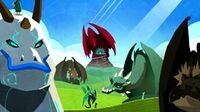
Like Eliatrope, the Great Dragon does not interact with reality in any known way. As intelligent as their Eliatrope kin, Dragons had the ability to shapeshift into different forms. Although in the Wakfu era Grougaloragran and Adamai take on humanoid appearances (the former as a brown skinned Cra, the latter as a white and blue skinned human), depictions of the past show ancient dragons in their true form alongside their tiny Eliatrope fellows. Young dragons appear to be the same size as their siblings, although at some point they have a growth spurt (since Adamai and Yugo are currently teenagers, it's must occur in the 20's or later). Newborn Dragons have a degree of capability to them as they are immediately able to walk, fly, and shoot small bursts of flames while their newborn Eliatrope siblings are typical human-like infants.
No Dragons other than the firstborn six are described as existing, although in the Wakfu cartoon a flashback depiction of Glip and Baltazar teaching a crowd of many young Eliatropes and Dragons. In addition, when the Emrub Eliatropes emerge there are no dragons other than Baltazar among them. It may be implied then that the Dragon race other than the first six perished with the fall of the Eliatropes, although this would still be speculation.
Each immortal dragon has a similar personality to their sibling although in the Wakfu cartoon Adamai is slightly more impulsive than Yugo, Qilby has gone thoroughly insane from the ennui of his life while Shinonome remains a voice of reason (speaking telepathically as a fetus from inside her Dofus), and while the newborn infant Chibi is trusting of Qilby (he's just a baby after all) the newborn Grougaloragran is hostile to him and tries to attack him.
Human Gods/Races
Each human "race" takes the form of the god they worship, although some take different forms based on how their faith works and the strength of the gods. Each god name comes from a pun of some kind.
Osamodas
Derived from "Sadomaso" as they are the beast taming class and the animal loving hippies/frontiersmen of the setting. Known for stealing all the Ecaflip wimmen.
Back in the Dofus era they were tan skinned humans with small horns, but in the Wakfu era Osamodas took on a blue-skinned white-haired look. Humans who worship Osamodas have powers over animals, being able to "collect" their essence and gain their strengths like most fantasy setting Shamans. Osamodas in the Wakfu era often keep a symbiotic pet called a Gobgob close to them. Gobgobs are explained to be "mineral" beings who gain powers by eating stones (and Orgines). Their intelligence is unknown, but they are described to worship Osamodas as well. Gobgobs feed on the Wakfu of their master, and as a result die and heal at the same time. It's not known how an Osamodas gains a Gobgob or if they can dismiss them afterwards although they are described as being given to apprentice adventurers. Despite this few Osamodas depicted in the cartoon are shown to have one. They eat souls to transform into the shape of animals, although they don't absorb them and spit them out afterwards while retaining the knowledge of the being's essence. In the Dofus era, Osamodas would summon animals straight from Incarnum to aid them. Ogrests Chaos disrupted this power, hence the creation of Gobgobs during the reconstruction of the world.
Back in the Dofus era, Foggernauts worshiped Osamodas as well, but as a god of the sea and as a result they are a mostly seafaring race that were mostly just blond humans overly fond of brass. The Foggernauts developed Wakfu-based steampunk technology, like primitive Eliatropes. Ogrests Chaos and the rising seas fucked them over royally, they lost faith in Osamodas and the other gods in general and became a reclusive race that developed their nation of Sufokia. They finally make contact with the world again in the Wakfu cartoon, where they have advanced beyond their steampunk era and into 80's style submarines that transform into giant robots. They use their formidable forces to beat back a full fledged invasion of Rushu back into his realm. Their prince, Adale, is...effeminate, and implies the eventual goal of the Sufokians is to kill the gods (he's also apparently a fan of Kerub as his prized "ancient teacup" bears his likeness). Mofette, their general (nicknamed "Admiral Crazytits" by /co/ and the Wakfu community at large) is a batshit insane and sadistic brute GLORIOUSLY AMAZING LEADER THAT WADED INTO THE THICK OF BATTLE TO WIN VICTORY ON THE BEACH!
In the Wakfu game, Foggernauts are playable as human souls that reincarnated into the bodies of robots that run on Stasis (all of which appear to be males unfortunately).
-
Osamodas as worshipped by the Osamodas race.
-
Oktapodas, an aspect of Osamodas worshipped by Foggernauts in the Dofus era.
-
An Osamodas male from the Dofus era.
-
An Osamodas female from the Dofus era.
-
Osamodas in the Wakfu era.
-
Foggernaut male in the Dofus era.
-
Foggernaut female in the Dofus era.
-
Wakfu era Foggernauts. On the left, Prince Adale. On the right, General Mofette.
-
The other kind of Wakfu Foggernauts.
-
The Sufokian military. Yes, these ladies managed to beat back the Chaos God of the setting.
Sadida
Plant people who worship Sadida. Sadida is Adidas backwards, referring to how the race are almost always barefoot.
Sadidas are a race of vaguely Polynesian druidic people (the kind that summon naughty tentacles vines out of nowhere rather than the animal-worshiping kind) with planet-like bodies. They have their own kingdom which contains a tree that binds their entire race together. If that tree is destroyed, their skin turns to wood (they don't die however; "fast worst than death" style, so no reincarnation). Guess what becomes a plot in the cartoon? If you said "socks", you're fucking wrong!
Sadida males have green beards which cover their entire faces, and somehow the race method of reproduction is to harvest babies from a cabbage patch as shown in the credits of an episode of Wakfu (although fans have theorized that was in fact a depiction of a ritual celebrating the time that Sadida babysat the infant Goultard while partaking of the sacred herb, called "Peas Nut Innaoven") despite them being humans.
There is quite a bit of diversity amongst the race outside the kingdom, ranging from humans that look like monkeys (literally, like little Bonobos) to gangly swamp Sadidas that have inhuman body proportions to swamp Sadidas who appear to be more fungus than plant.
In order to ensure there would be Dragons in the world (why he cared, nobody really knows) Sadida created a series of living dolls using part of his soul. As a result, Sadidas can place a portion of their souls into dolls of various kinds which help them fight. In the animated series, Princess Amalia (one of the main characters) has a doll which is loyal while behaving independent of herself, and during episodes in which she is possessed or mind-controlled behaves the same as she would. In the vidya however the dolls last only one fight, with multiple ones summoned at a time including suicide bomber ones.
Along with Osamodas, Sadida is the god most responsible for the state of the world. As part of their reconstruction efforts to fix the damage caused by Ogrests Chaos the two collaborated on giving most animals "seeds" that can be harvested from corpses which can be planted to regrow more (this is more of a game mechanic than outright canon, but until otherwise contradicted...).
Sadida is one of the less mentally stable gods, and adopts different personalities as he wears different masks. Although the Sadida race generally ignore this aspect, a whole different race takes part in this aspect; Masqueraiders. A very VERY fucking unpredictable race in the truest sense of "Chaotic Neutral", they wear a multitude of different masks and their goals/behavior differs based on which one they are wearing. They use powers granted by these masks in combat and switch between them rapidly, which makes them even MORE unpredictable.
-
Sadida as worshipped by Sadidas.
-
Sadida as worshipped by Masqueraiders.
-
Sadida male in the Dofus era.
-
Sadida female in the Dofus era.
-
Wakfu era Sadidas.
-
Masqueraider male in the Dofus era.
-
Masqueraider female in the Dofus era.
-
Wakfu era Masqueraiders.
-
A Sadida community.
-
Sadida femme.
-
Sadida masculine.
-
Sadida reproduction methods. Your guess is as good as anyone else's.
-
Xelor
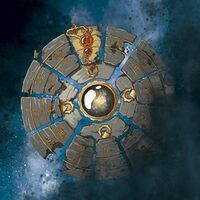
Time wizards, and Rolex backwards. The god Xelor is the one who created time and made it measurable when he descended to the World of Twelve. He created a clock by pooling a portion of reality and the Wakfu it contained and formed a swarm of bronze butterflies which formed the body and internal mechanisms of a clock. He created four more transparent ones hitched to the mechanisms, then set a magical frog to follow them around it. He set the rhythm of the frog's heart to the beat of the six Dofus, which all other being's hearts are set to as well. He set eleven purple magical gems around the outside of the clock to mark the months, then struck the ground of the World of Twelve with his magic hammer. The reverberating sound "tick" and "tock" were placed in his pocket, then added to the clock. Finally he set the seasons to the transparent butterflies. Each season was dedicated to one of his fellow gods: Summer for Iop, Ecaflip, and Cra, Fall for Feca and himself; Winter for Sram, Enutrof and Osamodas; and Spring for Eniripsa and Sadida. Rushu demanded in on the clock idea to make himself permanently bound to the world, and scratched a mark for December which caused black maggots to grow to slow down the butteflies and make the final month. When Sacrier joined the ranks of the gods, she made the gods feel the mortality of their followers in the seconds and shed a tear which caused an anomaly that causes Bonta and Brakmar to rebuild each time they destroy each other.
The Xelors themselves wrap themselves in bandages and in armor in the Wakfu era, as they are prone to turning to dust in not-so advanced age. As a result, it's almost impossible to tell how old any actually are. Dofus Xelor appeared more like ordinary humans. They link themselves to the TICK TOCK mechanism of the clock to work their powers.
Also worth pointing out that Nox is NOT actually a Xelor. He's just some asshole Wakfu addict running around in wrap-face.
-
Xelor.
-
Male Xelor from the Dofus era.
-
Female Xelor from the Dofus era.
-
Xelors from the Wakfu era.
-
-
Xelor himself is a dick.
-
Because Mormons don't get to stop time.
Iop
-
Iop
-
Goultard, demigod son of Iop, and his replacement post-Wakfu.
-
Dofus era Iop male.
-
Dofus era Iop female.
-
Iops, the default warrior badasses. Tend to get their dicks/vagoos stuck on Cra.
Cra
-
Cra
-
Dofus era Cra male.
-
Dofus era Cra female.
-
Cras, the default haughty archers. Not actually elves. Tsundere for Iops.
Ecaflip
-
Ecaflip in the Dofus era. Owner and DJ of a popular romantic nightclub.
-
Ecaflip as he appears in the Wakfu era.
-
Dofus era Ecaflip male.
-
Dofus era Ecaflip female.
-
Ecaflips, gamblers and merchants. Despite being furry, having prehensile tails and retractable claws, purring and hissing, and being tamed (sexually) by Osamodas, they're 100% genetically human. Some can control their fleas as a swarm.
Eniripsa
-
Eniripsa
-
Dofus era Eniripsa male.
-
Dofus era Eniripsa female.
-
Eniripsas. Human-sized fairies, healers and alchemists ("Eniripsa" = "Aspirine"). Twelve help you if you piss one off.
Feca
-
Feca
-
Dofus era Feca male.
-
Dofus era Feca female.
-
Fecas, min/maxing science NEEEERDS! Decent melee warriors.
Enutrof
-
Enutrof
-
Dofus era Enutrof male.
-
Dofus era Enutrof female.
-
Enutrofs, AKA Dwarfs. "Enutrof" = "Fortune"; they are miserly and greedy, though not necessarily unkind.
Sram
-
Sram as worshipped by Srams.
-
Sram as worshipped by Rogues.
-
Dofus era Sram male.
-
Dofus era Sram female. Wait, what?
-
Srams, the assassins. For some reason in Dofus, males were skeletons (2spooky) while females were chicks that shopped exclusively at Hot Topic. In the Wakfu era, they just wear Halloween costumes all year.
-
Dofus era Rogue male.
-
Dofus era Rogue female.
-
Rogues. They worship a different aspect of Sram. Their fondness of explosives, cheeky/chaotic lulz behavior, and general dickishness makes them the class for default shenanigans.
Sacrier
-
Sacrier
-
Dofus era Sacrier male.
-
Dofus era Sacrier female.
-
Sacriers, the OTHER warrior class of the setting. Gain power from their and their opponent's pain, can make weapons out of their blood in the Dofus era, out of tattoos in Wakfu.
Pandawa
-
Pandawa
-
Dofus era Pandawa male.
-
Dofus era Pandawa female.
-
Pandawas. Once again, totally human. Wine swilling monks who are totally not Pandaren. Carry around kegs of booze at all times, always brewing more on the go.
Rushu
-
Rushu, in his assumed form.
Non-human Sentients
Ouginaks
-
The one on the left is a glorious human warrior. The one on the right is a Gnoll. Welcome to Wakfu.
Puddlings
Bullies
Dragons
Gallery
-
The rules of Wakfu, applied to 40k.
-
The adventures of the Brotherhood of Tofu.
See Also
Krosmaster for the tabletop game that is based on it. Wakfu TCG for the trading card game.
